
The Enchanting Heart of Vilnius: Old Town
Discover the charm and history of Vilnius Old Town: A UNESCO World Heritage site rich in architecture, culture, and vibrant street life.
Step into the heart of Vilnius and be transported back in time as you wander through the cobblestone streets of Old Town. This UNESCO World Heritage site is a treasure trove of history, architecture, and culture. The area is renowned for its Baroque, Gothic, and Renaissance buildings that stand as a testament to the city's rich and diverse past. The beautifully preserved churches, such as the iconic St. Anne's Church and the majestic Vilnius Cathedral, are must-see landmarks that provide a glimpse into the city's spiritual heritage. Old Town is not just about historical monuments; it is also a bustling hub of modern life. Numerous cafes, restaurants, and shops line the streets, offering visitors a chance to sample local cuisine and shop for unique souvenirs. The vibrant atmosphere is further enhanced by street performers, local markets, and various festivals that take place throughout the year. Whether you're a history buff, a foodie, or simply someone who enjoys exploring charming streets, Old Town has something to offer everyone. As you explore, don't miss the chance to visit the Vilnius University, one of the oldest in Eastern Europe, and the Gates of Dawn, a significant religious site. The blend of old-world charm and contemporary vibrancy makes Old Town a captivating destination for any traveler.
Local tips in Old Town
- Wear comfortable shoes; the cobblestone streets can be uneven.
- Visit early in the morning or late in the evening to avoid crowds.
- Try traditional Lithuanian dishes at local restaurants for an authentic experience.
- Take a guided tour to learn about the history and significance of key landmarks.
- Check the local calendar for festivals and events to enhance your visit.
The Enchanting Heart of Vilnius: Old Town
Step into the heart of Vilnius and be transported back in time as you wander through the cobblestone streets of Old Town. This UNESCO World Heritage site is a treasure trove of history, architecture, and culture. The area is renowned for its Baroque, Gothic, and Renaissance buildings that stand as a testament to the city's rich and diverse past. The beautifully preserved churches, such as the iconic St. Anne's Church and the majestic Vilnius Cathedral, are must-see landmarks that provide a glimpse into the city's spiritual heritage. Old Town is not just about historical monuments; it is also a bustling hub of modern life. Numerous cafes, restaurants, and shops line the streets, offering visitors a chance to sample local cuisine and shop for unique souvenirs. The vibrant atmosphere is further enhanced by street performers, local markets, and various festivals that take place throughout the year. Whether you're a history buff, a foodie, or simply someone who enjoys exploring charming streets, Old Town has something to offer everyone. As you explore, don't miss the chance to visit the Vilnius University, one of the oldest in Eastern Europe, and the Gates of Dawn, a significant religious site. The blend of old-world charm and contemporary vibrancy makes Old Town a captivating destination for any traveler.
Iconic landmarks you can’t miss
Vilnius Cathedral
Explore Vilnius Cathedral, a stunning neoclassical masterpiece and a vital part of Lithuania's spiritual and cultural heritage.

Gate of Dawn
Explore the Gate of Dawn in Vilnius, a historic pilgrimage site blending spirituality with stunning architecture and rich cultural heritage.

Gediminas Castle Tower
Discover Lithuania's rich history at Gediminas Castle Tower, an iconic fortress offering stunning views and captivating museum exhibits in Vilnius.

Palace of the Grand Dukes of Lithuania
Explore the Palace of the Grand Dukes of Lithuania, a historical museum that unveils the glory and heritage of Lithuania's royal past in Vilnius.

Vincas Kudirka Square
Discover the serene beauty and rich heritage of Vincas Kudirka Square, a must-visit park in the heart of Vilnius, Lithuania.

Cathedral Square
Discover the vibrant essence of Vilnius at Cathedral Square, the heart of Lithuania's capital, rich in history and architectural beauty.
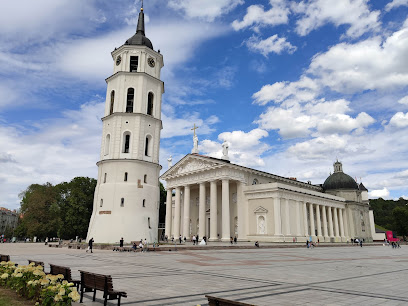
Town Hall Square
Discover the vibrant history and culture of Vilnius at Town Hall Square, the city's lively and picturesque heart, surrounded by stunning architecture.
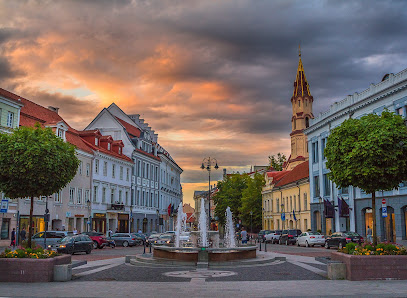
Bell Tower of Vilnius Cathedral
Explore the Bell Tower of Vilnius Cathedral, a historical landmark offering stunning views and a glimpse into the rich heritage of Lithuania.

Monument to Grand Duke Gediminas
Explore the Monument to Grand Duke Gediminas in Vilnius, a stunning sculpture celebrating Lithuania's history and heritage.

Ducal Palace of the Upper Castle
Discover the rich heritage and stunning architecture of the Ducal Palace of the Upper Castle in Vilnius, a historical landmark steeped in royal history.
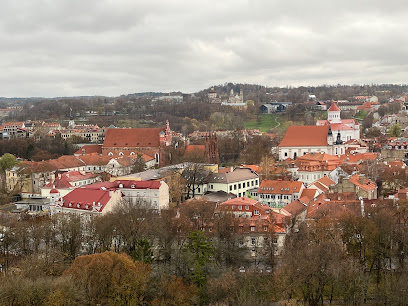
Unmissable attractions to see
Vilnius Cathedral
Discover the architectural splendor and historical significance of Vilnius Cathedral, a must-visit landmark in the heart of Lithuania's capital.

Three Crosses Monument
Discover the Three Crosses Monument in Vilnius – a breathtaking symbol of resilience surrounded by lush landscapes and rich history.

St. Anne's Church
Explore the breathtaking Gothic architecture of St. Anne's Church, a historical gem in Vilnius, and immerse yourself in its serene beauty.

Essential places to dine
Etno Dvaras
Experience authentic Lithuanian cuisine at Etno Dvaras in Vilnius – where tradition meets flavor in every dish.

Lokys
Discover the essence of Lithuania through its authentic cuisine at Lokys in Vilnius, where tradition meets taste.

EtnoDvaras
Experience authentic Lithuanian cuisine at EtnoDvaras in Vilnius - a culinary journey through tradition and flavor.

Galo do Porto
Experience authentic Portuguese cuisine at Galo do Porto in Vilnius—where traditional flavors meet modern elegance.

Ertlio Namas
Discover authentic Lithuanian cuisine at Ertlio Namas, where tradition meets modernity in every delightful dish.

Bunte Gans
Experience authentic German cuisine at Bunte Gans in Vilnius - where every meal is a celebration of flavor!
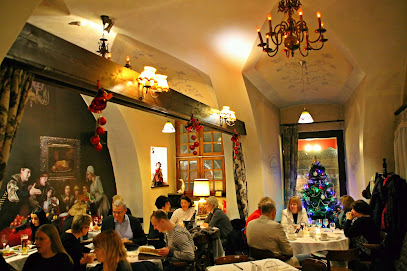
Bazilijonai
Savor the essence of Lithuania at Bazilijonai - where tradition meets taste in every dish.

12 Istorijų
Experience authentic Lithuanian cuisine at 12 Istorijų in Vilnius - where tradition meets modern culinary art.

Medininkai
Discover Medininkai: A delightful blend of traditional Lithuanian cuisine and modern dining experiences in Vilnius.

California Tapas & Wine Bar
Experience the flavors of Spain at California Tapas & Wine Bar in Vilnius – where exquisite tapas meet exceptional wines.

Markets, malls and hidden boutiques
PLC Panorama
Discover PLC Panorama in Vilnius - the ultimate shopping destination offering a mix of high-end brands, local treasures, and a vibrant atmosphere.

Ragainė - Baltik shop
Explore Ragainė, a unique gift and music shop in Vilnius, offering handcrafted souvenirs and authentic Lithuanian folk music.

OUTLET BOUTIQUE
Explore Vilnius' Outlet Boutique for stylish footwear that blends comfort and fashion in a charming shopping atmosphere.

De'Žavu Vintage Boutique
Discover unique vintage fashion and accessories at De'Žavu Vintage Boutique in Vilnius, a must-visit for style enthusiasts seeking timeless elegance.

Vintage boutique
Explore Vilnius' Vintage Boutique for one-of-a-kind high-end fashion pieces that tell a story and enhance your wardrobe.

Savva Vintage & Arts
Explore the charm of Savva Vintage & Arts, where unique vintage items and local artistry come together in the heart of Vilnius.

Šapokliak salon
Explore Šapokliak Salon, Vilnius' hidden gem for antiques, chinaware, and handcrafted gifts, perfect for unique souvenirs.

Old Town Boutique
Discover unique handcrafted treasures and local designs at Old Town Boutique in the heart of Vilnius, a must-visit for every traveler.
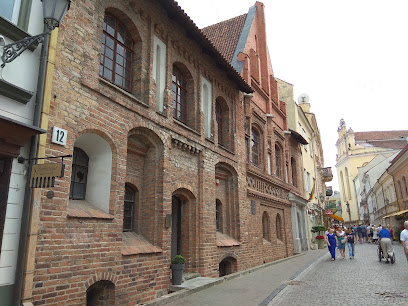
Lipdau
Explore Lipdau in Vilnius for exquisite handmade ceramics and unique souvenirs that beautifully represent Lithuanian culture and craftsmanship.

Ethno Baltic shop
Explore the Ethno Baltic Shop in Vilnius for unique handcrafted gifts and souvenirs that embody the rich cultural heritage of the Baltic region.

Essential bars & hidden hideouts
Uncle Sam's American pub
Experience the vibrant atmosphere of Uncle Sam's American Pub, where classic American cuisine meets Lithuanian charm in the heart of Vilnius.

Piano Man Bar
Discover the lively spirit of Vilnius at Piano Man Bar, where great drinks, live music, and a vibrant atmosphere await.

The pub Leičiai
Experience authentic Lithuanian flavors and craft beers at Leičiai Pub, a vibrant gem in the heart of Vilnius.

Gringo pub
Experience the vibrant spirit of Vilnius at Gringo Pub, where local culture meets international flair in a lively atmosphere.

Bukowski Baras Vilnius
Experience the vibrant nightlife at Bukowski Baras in Vilnius, where creative cocktails and lively ambiance await every evening.

Alchemikas
Discover Alchemikas in Vilnius, where innovative cocktails meet a vibrant atmosphere, perfect for a memorable night out in the city.

Who Hit John
Discover the vibrant nightlife of Vilnius at Who Hit John, a lively bar known for its eclectic atmosphere and extensive drink menu.
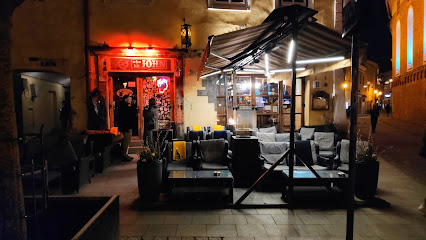
Apoteka Bar
Discover innovative cocktails and a vibrant atmosphere at Apoteka Bar, the premier cocktail destination in Vilnius for nightlife enthusiasts.
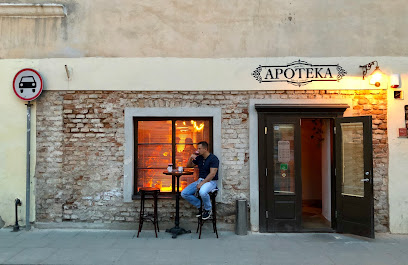
Spiritus Baras
Experience the lively ambiance and extensive drink selection at Spiritus Baras, a must-visit bar in the heart of Vilnius.

Dream Bar by Stikliai
Experience the vibrant nightlife of Vilnius at Dream Bar by Stikliai, where expertly crafted cocktails meet a cozy, welcoming ambiance.

Local Phrases
-
- HelloLabas
[lah-bahs] - GoodbyeViso gero
[vee-soh geh-roh] - YesTaip
[taeep] - NoNe
[neh] - Please/You're welcomePrašau
[prah-sow] - Thank youAčiū
[ah-choo] - Excuse me/SorryAtsiprašau
[aht-see-prah-sow] - How are you?Kaip gyveni?
[kaip gweh-neh] - Fine. And you?Gerai. O tu?
[geh-rah-ee. oh too] - Do you speak English?Ar kalbate anglų kalba?
[ahr kahl-bah-teh ahng-loo kahl-bah] - I don't understandAš nesuprantu
[ahsh neh-soo-prahn-too]
- HelloLabas
-
- I'd like to see the menu, pleaseNorėčiau pamatyti meniu, prašau
[noh-reh-chow pah-mah-tea men-yoo, prah-sow] - I don't eat meatAš nevalgau mėsos
[ahsh neh-vahl-gow meh-sohs] - Cheers!Į sveikatą!
[ee svee-kah-tah] - I would like to pay, pleaseNorėčiau sumokėti, prašau
[noh-reh-chow soo-moh-keh-tee, prah-sow]
- I'd like to see the menu, pleaseNorėčiau pamatyti meniu, prašau
-
- Help!Pagalba!
[pah-gahl-bah] - Go away!Išeik!
[ee-sheh-ik] - Call the Police!Paskambinkite policijai!
[pah-skahm-been-kee-teh poh-lee-tsee-yai] - Call a doctor!Pakvieskite gydytoją!
[pahk-vee-ehs-kee-teh ghee-dih-toh-yai] - I'm lostAš pasiklydau
[ahsh pah-see-kluh-dow] - I'm illAš sergu
[ahsh sehr-goo]
- Help!Pagalba!
-
- I'd like to buy...Norėčiau nusipirkti...
[noh-reh-chow noo-see-peerk-tee] - I'm just lookingAš tik žiūriu
[ahsh teek zhyoo-ree-oo] - How much is it?Kiek tai kainuoja?
[kyehk tahy kai-noo-oh-yah] - That's too expensiveTai per brangu
[tai pehr brahn-goo] - Can you lower the price?Ar galite sumažinti kainą?
[ahr gah-lee-teh soo-mah-zihn-tee kai-nah]
- I'd like to buy...Norėčiau nusipirkti...
-
- What time is it?Kiek valandų?
[kyehk vah-lahn-doo] - It's one o'clockViena valanda
[vyeh-nah vah-lahn-dah] - Half past (10)Dešimt pusė
[deh-shimt poo-seh] - MorningRytas
[rih-tahs] - AfternoonPopietė
[poh-pyeh-teh] - EveningVakaras
[vah-kah-rahs] - YesterdayVakar
[vah-kahr] - TodayŠiandien
[shahn-dyehn] - TomorrowRytoj
[rih-toy] - 1Vienas
[vyeh-nahs] - 2Du
[doo] - 3Trys
[treese] - 4Keturi
[keh-too-ree] - 5Penki
[pehn-kee] - 6Šeši
[sheh-shee] - 7Septyni
[sehp-tee-nee] - 8Aštuoni
[ahs-too-oh-nee] - 9Devyni
[deh-vih-nee] - 10Dešimt
[deh-sheemt]
- What time is it?Kiek valandų?
-
- Where's a/the...?Kur yra...?
[koor uhr-ah] - What's the address?Koks adresas?
[kohks ah-dreh-sahs] - Can you show me (on the map)?Ar galite man parodyti (žemėlapyje)?
[ahr gah-lee-teh mahn pah-roh-dih-tee zheh-meh-lah-pyeh] - When's the next (bus)?Kada kitas (autobusas)?
[kah-dah kee-tahs ow-toh-boo-sahs] - A ticket (to ....)Bilietas (į ....)
[bee-lee-eh-tahs ee]
- Where's a/the...?Kur yra...?
History of Old Town
-
Vilnius, the capital of Lithuania, was founded in the late 14th century. The Old Town emerged as a vibrant center of culture and trade, strategically located at the confluence of the Neris and Vilnia rivers. According to legend, the Grand Duke Gediminas was guided by a dream of a iron wolf, prompting him to establish the city as a bastion of power and commerce.
-
During the 15th and 16th centuries, Old Town flourished under the Grand Duchy of Lithuania, becoming a hub of political power and cultural exchange. The construction of significant structures such as the Gothic-style St. Anne's Church and the Renaissance Vilnius University, founded in 1579, showcased the architectural diversity and intellectual vibrancy of the period.
-
The Old Town became a showcase of religious tolerance, with Catholic, Orthodox, and Jewish communities coexisting. The Great Synagogue of Vilnius, established in the 16th century, symbolized the thriving Jewish culture in the area, which contributed to the rich tapestry of Old Town's multicultural identity.
-
In the late 18th century, the partitions of Poland led to the division of Lithuania, impacting Vilnius significantly. Under Russian control, Old Town saw a mix of architectural influences, with the introduction of neoclassical buildings while retaining its medieval charm. This period marked a shift in the city's administrative and cultural alignment.
-
The impact of World War II was profound, particularly for the Jewish community of Vilnius, which was decimated during the Holocaust. Post-war, Old Town underwent reconstruction and revitalization efforts, with many historical sites restored to preserve the city's heritage. The Old Town was designated a UNESCO World Heritage Site in 1994, recognizing its cultural and historical significance.
-
In recent decades, Old Town has experienced a renaissance, becoming a vibrant center for tourism, arts, and culture. Festivals, galleries, and cafes have revitalized the area, drawing locals and visitors alike. The neighborhood serves as a living museum, showcasing Lithuania's complex history and diverse cultural influences through its architecture, public spaces, and ongoing cultural events.
Old Town Essentials
-
Old Town is centrally located in Vilnius and easily accessible from other neighborhoods. You can reach Old Town by public transport, including buses and trolleybuses, which connect various parts of the city. The Vilnius Central Bus Station is located just outside Old Town, making it convenient for travelers arriving from other cities. Taxis and rideshare services are also widely available. If you're coming from the airport, a taxi ride to Old Town takes around 20 minutes, while public transport options are available, including buses that run frequently.
-
Old Town is best explored on foot, as it is a compact area filled with narrow cobblestone streets, historic buildings, and charming squares. Public transport options within Old Town are limited due to its size, but nearby bus and trolleybus stops make it easy to travel to other parts of the city. Bicycles can be rented from various locations, and there are bike lanes throughout Vilnius. Additionally, guided walking tours are a popular way to explore the neighborhood's rich history and architecture.
-
Old Town is generally safe for tourists, but it's wise to take standard precautions. Avoid poorly lit streets at night and keep your belongings secure, especially in crowded areas. Be cautious around popular tourist spots where pickpocketing may occur. Areas around bus and train stations can be busier and might have a higher concentration of petty crime. Always remain vigilant and trust your instincts.
-
In case of an emergency, dial 112 for police, medical, or fire assistance in Lithuania. Familiarize yourself with the location of the nearest hospital or clinic, and consider having travel insurance that covers medical emergencies. Pharmacies are available throughout Old Town for minor health issues, and many staff members can speak English.
-
Fashion: Do dress modestly when visiting churches and religious sites; avoid revealing clothing. Religion: Do respect local customs; take off your hat and cover your shoulders when entering places of worship. Public Transport: Do offer your seat to the elderly or disabled; don't consume food or beverages on public transport. Greetings: Do greet with a handshake and a smile; don't be overly informal with strangers. Eating & Drinking: Do try local dishes and drinks, particularly in traditional restaurants; don't refuse food or drink when offered, as it may be seen as impolite.
-
To experience Old Town like a local, visit the bustling Halės Market, where you can find fresh produce and traditional Lithuanian foods. Engage with local artisans and shopkeepers for unique souvenirs. Take time to explore lesser-known streets and alleys to discover hidden gems such as quaint cafes and galleries. Attend local festivals or cultural events if you're in town during the summer months, as they often feature music, dance, and traditional crafts. Lastly, don't forget to sample local specialties, such as cepelinai (potato dumplings) and šaltibarščiai (cold beet soup).
Nearby Cities to Old Town
-
Things To Do in Jonava
-
Things To Do in Kaunas
-
Things To Do in Utena
-
Things To Do in Marijampolė
-
Things To Do in Panevėžys
-
Things To Do in Daugavpils
-
Things To Do in Suwalki
-
Things To Do in Šiauliai
-
Things To Do in Bialystok
-
Things To Do in Riga
-
Things To Do in Jurmala
-
Things To Do in Sigulda
-
Things To Do in Klaipėda
-
Things To Do in Cesis
-
Things To Do in Olsztyn













